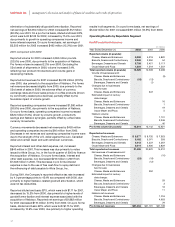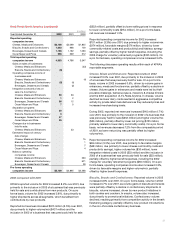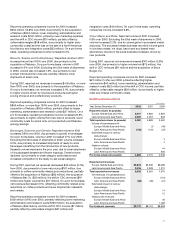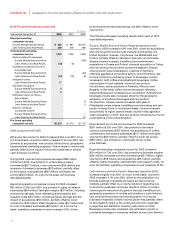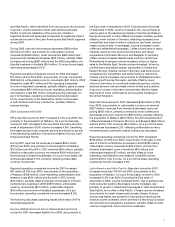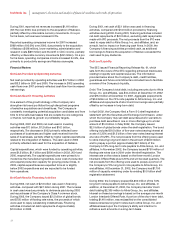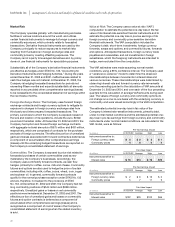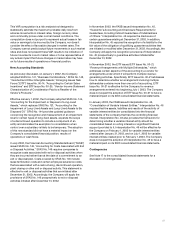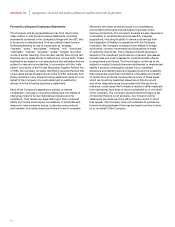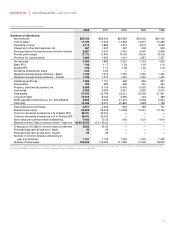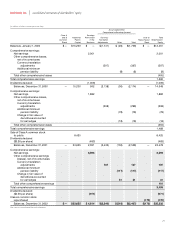Kraft 2002 Annual Report Download - page 44
Download and view the complete annual report
Please find page 44 of the 2002 Kraft annual report below. You can navigate through the pages in the report by either clicking on the pages listed below, or by using the keyword search tool below to find specific information within the annual report.
kraft foods inc. management’s discussion and analysis of financial condition and results of operations
Market Risk
The Company operates globally, with manufacturing and sales
facilities in various locations around the world, and utilizes
certain financial instruments to manage its foreign currency and
commodity exposures, which primarily relate to forecasted
transactions. Derivative financial instruments are used by the
Company, principally to reduce exposures to market risks
resulting from fluctuations in foreign exchange rates and
commodity prices by creating offsetting exposures. The
Company is not a party to leveraged derivatives and, by policy,
does not use financial instruments for speculative purposes.
Substantially all of the Company’s derivative financial instruments
are effective as hedges under SFAS No. 133, “Accounting for
Derivative Instruments and Hedging Activities.” During the years
ended December 31, 2002 and 2001, ineffectiveness related to
cash flow hedges was not material. At December 31, 2002, the
Company is hedging forecasted transactions for periods not
exceeding fifteen months and expects substantially all amounts
reported in accumulated other comprehensive earnings (losses)
to be reclassified to the consolidated statement of earnings within
the next twelve months.
Foreign Exchange Rates: The Company uses forward foreign
exchange contracts and foreign currency options to mitigate its
exposure to changes in foreign currency exchange rates from
third-party and intercompany forecasted transactions. The
primary currencies to which the Company is exposed, based on
the size and location of its operations, include the euro, British
pound and Canadian dollar. At December 31, 2002 and 2001, the
Company had option and forward foreign exchange contracts
with aggregate notional amounts of $575 million and $431 million,
respectively, which are comprised of contracts for the purchase
and sale of foreign currencies. The effective portion of unrealized
gains and losses associated with forward contracts is deferred as
a component of accumulated other comprehensive earnings
(losses) until the underlying hedged transactions are reported on
the Company’s consolidated statement of earnings.
Commodities: The Company is exposed to price risk related to
forecasted purchases of certain commodities used as raw
materials by the Company’s businesses. Accordingly, the
Company uses commodity forward contracts, as cash flow
hedges, primarily for coffee, cocoa, milk and cheese. Commodity
futures and options are also used to hedge the price of certain
commodities, including milk, coffee, cocoa, wheat, corn, sugar
and soybean oil. In general, commodity forward contracts
qualify for the normal purchase exception under SFAS No. 133
and are, therefore, not subject to the provisions of SFAS
No. 133. At December 31, 2002 and 2001, the Company had net
long commodity positions of $544 million and $589 million,
respectively. Unrealized gains or losses on net commodity
positions were immaterial at December 31, 2002 and 2001. The
effective portion of unrealized gains and losses on commodity
futures and option contracts is deferred as a component of
accumulated other comprehensive earnings (losses) and is
recognized as a component of cost of sales in the Company’s
consolidated statement of earnings when the related inventory
is sold.
Value at Risk: The Company uses a value at risk (“VAR”)
computation to estimate the potential one-day loss in the fair
value of its interest rate-sensitive financial instruments and to
estimate the potential one-day loss in pre-tax earnings of its
foreign currency and commodity price-sensitive derivative
financial instruments. The VAR computation includes the
Company’s debt; short-term investments; foreign currency
forwards, swaps and options; and commodity futures, forwards
and options. Anticipated transactions, foreign currency trade
payables and receivables, and net investments in foreign
subsidiaries, which the foregoing instruments are intended to
hedge, were excluded from the computation.
The VAR estimates were made assuming normal market
conditions, using a 95% confidence interval. The Company used
a “variance/co-variance” model to determine the observed
interrelationships between movements in interest rates and
various currencies. These interrelationships were determined by
observing interest rate and forward currency rate movements
over the preceding quarter for the calculation of VAR amounts at
December 31, 2002 and 2001, and over each of the four preceding
quarters for the calculation of average VAR amounts during each
year. The values of foreign currency and commodity options do
not change on a one-to-one basis with the underlying currency or
commodity, and were valued accordingly in the VAR computation.
The estimated potential one-day loss in fair value of the
Company’s interest rate-sensitive instruments, primarily debt,
under normal market conditions and the estimated potential one-
day loss in pre-tax earnings from foreign currency and commodity
instruments under normal market conditions, as calculated in the
VAR model, were as follows:
Pre-Tax Earnings Impact
(in millions) At 12/31/02 Average High Low
Instruments sensitive to:
Foreign currency rates $5 $2 $5 $1
Commodity prices 46 94
Fair Value Impact
(in millions) At 12/31/02 Average High Low
Instruments sensitive to:
Interest rates $ 76 $74 $ 76 $70
Pre-Tax Earnings Impact
(in millions) At 12/31/01 Average High Low
Instruments sensitive to:
Foreign currency rates $ 2 $6 $13 $2
Commodity prices 57115
Fair Value Impact
(in millions) At 12/31/01 Average High Low
Instruments sensitive to:
Interest rates $122 $79 $122 $56
40




